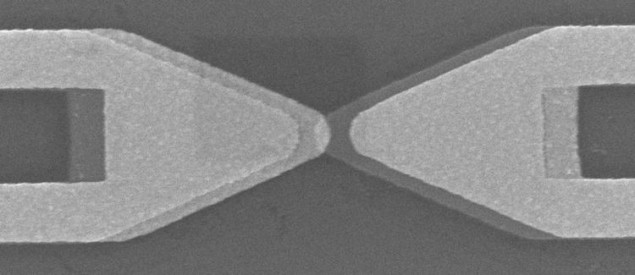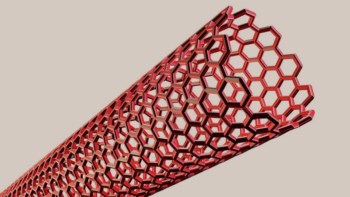
Devices known as optical rectennas show considerable promise for renewable energy because they can harvest energy from heat and convert it into electricity. Their chief drawback is their low efficiency, which makes them impractical for large-scale use. Researchers at the University of Colorado, Boulder, US have now found a way to boost this efficiency, paving the way for optical rectennas that can generate useful amounts of electrical power from waste heat.
Rectennas (short for rectifying antennas) consist of two parts: an antenna, which absorbs electromagnetic radiation, and a diode, which converts the absorbed energy into direct current. Optical rectennas, which convert electromagnetic fields at optical frequencies into electrical current, work most efficiently when made on the micron or sub-micron scales, which is much smaller than devices that convert longer-wavelength radiation such as radio waves. The problem is that as these devices shrink, their electrical resistance grows, thus drastically limiting their power output.
Sidestepping the obstacle
Faced with this no-win situation, a Boulder team led by Amina Belkadi, Garret Moddel and Ayendra Weerakkody decided to explore whether they could sidestep the obstacle entirely. In a conventional rectenna, electrons must pass through an insulator, which adds resistance to the device, reducing the amount of electricity it can produce. In the new work, Belkadi and her colleagues decided, somewhat counterintuitively, to build a rectenna that uses two insulators instead. They did this because having a space between the insulators makes it possible for a structure known as a quantum well to form.
This quantum well contains discrete quasi-bound electronic states, and electrons that hit it with energies matching the states’ energy levels can then propagate through the structure without much resistance. This propagation process is termed resonant tunnelling, and it enables tunnelling electrons to produce a higher current compared to non-resonant electrons.
Low resistance and high responsivity
While such behaviour had been predicted in theory, it had not previously been observed experimentally. To produce it, the researchers had to choose the materials for their rectenna carefully and then fabricate them with the correct thickness.
In their work, which they detail in Nature Communications, Belkadi, Moddel and Weerakkody studied rectennas made from Ni/NiO/Al2O3/Cr/Au metal-double-insulator-metal (MI2M) wafers. The quantum wells formed between the two oxides NiO and Al2O3. The researchers began by dividing each wafer into four Ni/NiO/Al2O3/Cr/Au diode batches. They then varied the thicknesses of the NiO layers (from 3 to 6 nm) to modify the depth and width of the MI2M quantum wells, while keeping the thickness of the Al2O3 at 1.3 nm.
They found that the devices responded better to light as the thickness of the NiO layer increased from 3-5 nm, producing currents of 0.43 A/W at 3 nm, 0.52 A/W at 4 nm, and 0.59 A/W at 5 nm thicknesses. The device’s resistance, meanwhile, dropped from 10 kΩ for the 3 nm structure to a minimum of 4 kΩ for the 4 nm structure before increasing to 50 kΩ at 5 nm. After balancing these various trade-offs, and thanks to the electron resonant tunnelling effect, the researchers report that they were able to make a 0.035 μm2-sized device with a resistance of just 13 kΩ and a responsivity of 0.5 A/W.
Deeper quantum wells
To test their rectennas, the researchers placed a network of about 250 000 of them on a hotplate. They then increased the hotplate’s temperature and measured how much heat the devices were able to capture.
While the researchers found that devices in this configuration captured less than 1% of the hotplate’s radiation, they believe they can increase this figure by making the quantum wells in their devices deeper, which would allow more electrons to pass through. They would achieve this by using different metals and insulators. An optimized design could, they say, be used to harvest waste heat from sources ranging from power plants to industrial ovens.

Insulator layers give optical rectennas a boost
More ambitiously, the researchers say that it might, in principle, be possible to capture the energy radiating from Earth itself using rectennas mounted on airships. Moddel, in particular, looks forward to the day when rectennas sit on top of everything, from solar panels on the ground to lighter-than-air vehicles in the air. “If you can capture heat radiating into deep space, then you can get power anytime, anywhere,” he says.
Members of the team now plan to find out whether the effect they observed can be replicated in other materials, as well as in Ni/NiO/Al2O3/Cr/Au wafers with different thicknesses. “The goal is to find materials with a quasi-bound state near to the metal Fermi level,” Belkadi explains. “The closer the better since this will allow for lower resistance and higher diode efficiency.” Finding multiply-bound states would also be desirable, she tells Physics World, as it might push the technology forward enough to make it commercially viable.



